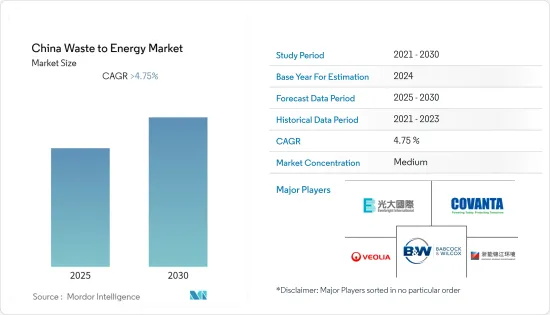 |
市场调查报告书
商品编码
1627110
中国WtE(垃圾发电):市场占有率分析、产业趋势与统计、成长预测(2025-2030)China Waste to Energy - Market Share Analysis, Industry Trends & Statistics, Growth Forecasts (2025 - 2030) |
||||||
价格
※ 本网页内容可能与最新版本有所差异。详细情况请与我们联繫。
简介目录
中国WtE(垃圾发电)市场预计在预测期内复合年增长率将超过4.75%

主要亮点
- 从长远来看,有利的政府措施和国内投资的增加预计将推动市场。
- 另一方面,市场成长是由垃圾焚化发电产生的有害气体排放和这些发电厂产生的灰烬推动的,这些灰烬通常需要在垃圾掩埋场安全处置,这可能导致地下水污染。
- 然而,到 2050 年,该地区人均每日废弃物产生量预计将增加近 40%。因此,该地区城市垃圾量的增加和能源需求的增加预计将为中国垃圾焚化发电市场提供未来的机会。
中国WtE(垃圾发电)市场趋势
基于热的废弃物能源转化主导市场
- 2019年,中国成为安装全球最大焚化厂(深圳东废弃物发电厂)的主要国家之一。该工厂每年将可处理270万吨废弃物,每年发电15亿度。
- 对于除了发电之外还利用热电汽电共生(供热和製冷)的工厂,最佳效率预计可达 80%。
- 目前,焚烧是都市固态废弃物(MSW)处理中最着名的垃圾焚化发电技术。
- 然而,垃圾焚化发电技术,尤其是焚烧,会产生污染并带来潜在的健康和安全风险。
- 为了减少颗粒物和气相排放,焚化厂业主采用了一系列製程装置来清洁烟气流,从而显着改善环境永续性。
加大投资带动市场
- 中国是世界第二大城市垃圾生产国。因此,我们在2017年启动了废弃物分类计划,目标是到2025年建成100个零废弃物城市。
- 全国废弃物排放将从2010年的1.58亿吨增加至2021年的2.487亿吨,增加约57.4%。
- 根据中国国家主席习近平的反污染计划,焚烧业预计将继续扩大并取代恶臭、污染和土地密集的垃圾场。中国人口众多,产生大量垃圾(每年增长 8-10%),因此正在寻找新的设施来燃烧固态废弃物来发电。
- 到2025年,中国固态废弃物产生量预计将翻一番,达到每年5亿吨以上。预计这一因素将在预测期内进一步推动该国对废弃物处理设施的巨大需求。
- 预计这些因素将在预测期内推动中国WtE(垃圾发电)市场的发展。
中国废弃物产业概况
中国废弃物发电市场适度细分。主要参与企业包括(排名不分先后)中国光大国际有限公司、浙能锦江环境控股有限公司、Babcock & Wilcox Enterprises Inc.、Covanta Holding Corporation 和 Veolia Environnement SA。
其他好处
- Excel 格式的市场预测 (ME) 表
- 3 个月分析师支持
目录
第一章简介
- 调查范围
- 市场定义
- 研究场所
第二章调查方法
第三章执行摘要
第四章市场概况
- 介绍
- 至2027年市场规模及需求预测(单位:十亿美元)
- 最新趋势和发展
- 政府法规和措施
- 市场动态
- 促进因素
- 抑制因素
- 供应链分析
- PESTLE分析
第五章 按技术细分市场
- 身体的
- 热的
- 生物
第六章 竞争状况
- 併购、合资、联盟、协议
- 主要企业策略
- 公司简介
- China Everbright International Limited
- Zheneng Jinjiang Environment Holding Co. Ltd
- Babcock & Wilcox Enterprises Inc.
- Covanta Holding Corporation
- Veolia Environnement SA
第七章 市场机会及未来趋势
简介目录
Product Code: 49282
The China Waste to Energy Market is expected to register a CAGR of greater than 4.75% during the forecast period.

Key Highlights
- Over the long term, favorable government policies and increasing investments in the country are expected to drive the market.
- On the other hand, the emission of harmful gases generated from waste-to-energy plants and the ash produced from these plants, which needs to be disposed of safely, usually in landfills, leading to groundwater contamination, may also hinder the growth of the market.
- However, the daily per capita waste generation in the region is expected to increase by nearly 40% by 2050. Thus, the increasing volume of municipal waste and rising demand for energy in the region are expected to create an opportunity for the waste-to-energy market in China in the future.
China Waste to Energy Market Trends
Thermal-based Waste-to-Energy Conversion to Dominate the Market
- In 2019, China became one of the prominent countries that installed the world's largest incineration plant (the Shenzhen East waste-to-energy plant). The plant can process 2.7 million ton of waste per year and generate 1.5 billion kilowatt-hours of power per year.
- Plants that utilize cogeneration of thermal power (heating and cooling), along with electricity generation, are estimated to reach optimum efficiencies of 80%.
- Presently, incineration is the most well-known waste-to-energy technology for municipal solid waste (MSW) processing.
- However, waste-to-energy technologies, particularly incineration, produce pollution and carry potential health safety risks.
- To reduce particulate and gas-phase emissions, incineration plant owners have adopted a series of process units for cleaning the flue gas stream, leading to a significant improvement in terms of environmental sustainability.
Increasing Investments to Drive the Market
- China is the second-largest producer of municipal waste in the world. Therefore, it initiated waste sorting plans in 2017 and aims to build 100 zero-waste cities by 2025.
- The country's disposed waste increased from 158 million ton in 2010 to 248.7 million ton in 2021, an increase of around 57.4%.
- Under Chinese President Xi Jinping's plan to tackle pollution, the incineration industry is expected to continue its expansion and replace stinky, polluting, land-intensive garbage dumps. With its massive population producing vast quantities of garbage (increasing by 8-10% annually), China is looking for new facilities that burn solid waste to produce electricity.
- By 2025, China's solid waste generation is expected to double to more than 500 million metric ton annually. This factor is further expected to create a huge demand for waste treatment facilities in the country during the forecast period.
- Such factors are expected to drive the market for waste to energy in China during the forecast period.
China Waste to Energy Industry Overview
China's waste-to-energy market is moderately fragmented. Some of the key players are (in no particular order) China Everbright International Limited, Zheneng Jinjiang Environment Holding Co. Ltd, Babcock & Wilcox Enterprises Inc., Covanta Holding Corporation, and Veolia Environnement SA.
Additional Benefits:
- The market estimate (ME) sheet in Excel format
- 3 months of analyst support
TABLE OF CONTENTS
1 INTRODUCTION
- 1.1 Scope of the Study
- 1.2 Market Definition
- 1.3 Study Assumptions
2 RESEARCH METHODOLOGY
3 EXECUTIVE SUMMARY
4 MARKET OVERVIEW
- 4.1 Introduction
- 4.2 Market Size and Demand Forecast in USD billion, till 2027
- 4.3 Recent Trends and Developments
- 4.4 Government Policies and Regulations
- 4.5 Market Dynamics
- 4.5.1 Drivers
- 4.5.2 Restraints
- 4.6 Supply Chain Analysis
- 4.7 PESTLE Analysis
5 MARKET SEGMENTATION BY TECHNOLOGY
- 5.1 Physical
- 5.2 Thermal
- 5.3 Biological
6 COMPETITIVE LANDSCAPE
- 6.1 Mergers and Acquisitions, Joint Ventures, Collaborations, and Agreements
- 6.2 Strategies Adopted by Leading Players
- 6.3 Company Profiles
- 6.3.1 China Everbright International Limited
- 6.3.2 Zheneng Jinjiang Environment Holding Co. Ltd
- 6.3.3 Babcock & Wilcox Enterprises Inc.
- 6.3.4 Covanta Holding Corporation
- 6.3.5 Veolia Environnement SA
7 MARKET OPPORTUNITIES AND FUTURE TRENDS
02-2729-4219
+886-2-2729-4219










